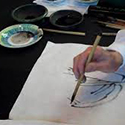|
|
| Show All 73 Results (Text Only) |
|
|
| Beliefs Made Visible: Understanding Hindu and Buddhist Art in South Asia [PDF] |
|
|
"Explore the basic tenets and influences of Hinduism and Buddhism throughout Asia. Special attention is given to the evolution of Hinduism and Buddhism in India, and the representation of these beliefs in sculpture and religious architecture (stupas, temples, caves, and so on). Includes lessons on the traditions of threshold art and handouts on the symbolic gestures of Buddhas."
Go to Museum Resource: https://education.asianart.org/wp-content/uploads/sites/6/2019/09/Beliefs-Made-... | |
|
|
|
|
|
| Brushstrokes: Styles and Techniques of Chinese Painting [PDF] |
|
|
"Brushpainting, which includes calligraphy, landscapes, scrolls and fans, has been a major art form throughout Chinese history. This packet explores the history, development and significance of brushpainting in Chinese art. Includes discussion of painting and calligraphy techniques, and a comparison of painting styles."
Go to Museum Resource: https://education.asianart.org/wp-content/uploads/sites/6/2019/09/Brushstrokes.... | |
|
|
| Bu and Bun: The Arts of War and Peace |
|
|
In addition to superior strategic and military ability, most elite samurai were expected to be versed in the cultural arts. The warrior’s ideal balance of military and artistic skill is captured well in this description of the sixteenth century daimyo Hosokawa Yusai (1534–1610): “Renowned for his elegant pursuits, he is a complete man combining arts [bun] and arms [bu]. A man of nobility, a descendant of the sixth grandson of the emperor Seiwa, he was a ruler endowed with awesome dignity and inspiring decorum…He built a splendid castle, which was majestic, beautiful and high…He discussed Chinese poetic styles and recited by heart the secret teachings of Japanese poetry…" See also Archery Practice.
Go to Museum Resource: https://education.asianart.org/resources/bu-and-bun-the-arts-of-war-and-peace/ | |
|
|
| Buddhist Caves at Ajanta |
|
|
Learn about Buddhist caves. This is one of a series of caves excavated out of the volcanic rock that extends along a cliff overlooking the Wagora River at Ajanta, about two hours north of the present-day city of Aurangabad, in Maharastra state in western India.
Go to Museum Resource: https://education.asianart.org/resources/buddhist-caves-at-ajanta/ | |
|
|
|
| Show All 73 Results (Text Only) |








